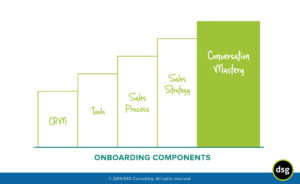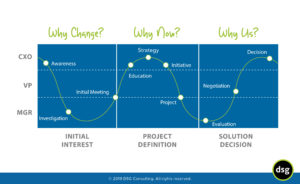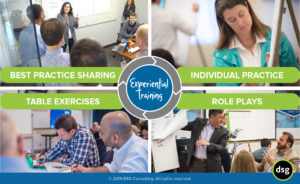A great first week of onboarding is not enough to accelerate new hire time-to-productivity. There is a gap in many organizations’ approaches to preparing sellers to lead compelling and repeatable customer conversations. Closing this gap means preparing new reps to lead an effective sales meeting through “conversation mastery.”
Conversation mastery is an accelerator to onboarding success—time-to-productivity, time-to-first deal, and a robust pipeline. Without conversation mastery, a new salesperson will not have the confidence or ability to get the initial customer meeting, build a healthy pipeline, and move deals through the sales cycle.

Define Common Sales Conversations
Conversation mastery begins with identifying your organization’s common and repeatable sales conversations. Are there 3 to 5 predictable conversations that your sellers will need to lead across the customer buying process stages of initial interest, project definition, and solution decision? (An example buying process for a complex B2B selling environment used by DSG is included below.) Debate the conversation types across your organization.

Here are four generic conversation categories. Your conversation types will be much more aligned to the buying process and prioritized personas.
- Get the Meeting: Utilizing an email, quick phone call, or in-person conversation to share insight and positioning that leads to an initial exploratory scheduled meeting
- Initial Meeting: Leading a 30 to 60 minute in-person or virtual conversation to expand on the insights, understand their needs, deliver a compelling value proposition, and get their agreement on the next steps in their buying process
- Solution Recommendation: Summarizing their business problems and opportunities in order to map the right solution to those priorities, confirm the business value of the solution, and gain stakeholder support
- Negotiation: Building on the business value foundation created throughout the earlier sales conversations to reach agreement on the options, trade-offs, costs, and terms
Once you’ve prioritized the conversations to master, salespeople will need something practical — such as a guide, playbook, or cheat sheet — that maps out what a salesperson needs to know to lead each conversation type. Show them what “good” looks like for your organization. Capture a top performer on your team modeling best practices of a prioritized conversation. Provide coaching videos explaining the conversation strategy and key messages. Give your new sellers delivery practice opportunities for each of your prioritized conversations with coaching and feedback opportunities.
Three Levels of Conversation Mastery
In the first 90 days, you want new sales reps to dive in and get productive. Conversation mastery is a great way to start thinking about your onboarding process as more than a new-hire training event.
Level One: Knowledge Ready
[0 – 30 days, Pre-Training]
The new rep reviews, listens to, or watches all of the materials available on the products, services, solutions, and personas. They gain an understanding of what the company does and discover what good looks like. At the end of this stage, a rep should be able to say, “I’m ready for hands-on training.”
Not everyone is hired on the same date. This level is for getting ready before the next new-hire bootcamp. There’s a lot of foundational knowledge for a new rep to absorb during this time like CRM knowledge, sales process knowledge, pricing, etc. But don’t miss knowledge transfer around prioritized sales conversations. Conversation mastery is an accelerator to productivity.
Level Two: Conversation Ready
[30 – 45 Days, New Hire Training]
Experiential training builds rep confidence and capabilities. Getting practice time with colleagues and thought leaders in the organization will help improve a new rep’s sales conversation game. A new rep should leave with the trainer saying, “You are ready. Go meet with customers.”

Often, companies spend that valuable 1 to 2-week boot camp time teaching new hires all about products and pricing with plenty of presentations and demos. If your organization is taking that approach, you’re missing an opportunity for experiential training focused on real-world selling scenarios in each of the prioritized conversation types. The more that you can transfer knowledge prior to face-to-face training, the more that you can increase impact. The most impactful in-person training is focused on building confidence and capability to deliver sales conversations. Sharing a myriad of slides will not give a salesperson the confidence or ability to lead a compelling conversation.
Level Three: Conversation Mastery
[45 – 90 Days, Post Training]
Your new sellers should immediately apply what they learned in experiential training. Start leading customer conversations with ongoing coaching and reinforcement from their sales manager. Join experienced sales colleagues in their sales conversations. As the manager observes their new reps’ progress, they should confirm the new seller has achieved conversation mastery. The manager should observe an interaction where he is able to say, “I heard you lead that conversation with the customer. You nailed it!” Initial onboarding is complete.
Managers are in the best position to determine that a new rep has mastered sales conversations. However, managers are often disconnected from the onboarding process. Managers should take over at “level three” to challenge reps to lead conversations and track progress on each.
Onboarding Takeaways
- Define the best practices your organization wants to replicate. Don’t train new sellers without breaking information down into simple, repeatable conversations that reps can master.
- Don’t waste valuable in-person training time on knowledge transfer. Use e-learning or a virtual playbook for new reps to learn foundational info prior to an in-person boot camp. Make the most of in-person time with experiential training that helps reps advance their capabilities.
- Include managers in onboarding. Managers are in the best position to provide the next level of coaching and development.
To learn more about how to implement sales conversations, and create an effective sales onboarding program to increase revenue, download Highspot’s newest eBook, Onboarding: The Key to Unlocking More Revenue.




